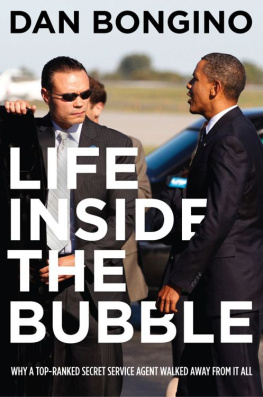

TO BE A U.S. SECRET
SERVICE AGENT
HENRY M. HOLDEN

First published in 2006 by Zenith Press, an imprint of MBI Publishing Company, 400 First Avenue North, Suite 300, Minneapolis, MN 55401 USA
Copyright 2006, 2010 by Henry M. Holden
Softcover edition published in 2006. Digital edition 2010.
All rights reserved. With the exception of quoting brief passages for the purposes of review, no part of this publication may be reproduced without prior written permission from the Publisher.
The information in this book is true and complete to the best of our knowledge. All recommendations are made without any guarantee on the part of the author or Publisher, who also disclaim any liability incurred in connection with the use of this data or specific details.
We recognize, further, that some words, model names, and designations mentioned herein are the property of the trademark holder. We use them for identification purposes only. This is not an official publication.
MBI Publishing Company titles are also available at discounts in bulk quantity for industrial or sales-promotional use. For details write to Special Sales Manager at MBI Publishing Company, 400 First Avenue North, Suite 300, Minneapolis, MN 55401 USA
Digital edtion: 978-1-61673-944-7
Softcover edition: 978-0-7603-2293-2
Editors: Steve Gansen and Lindsay Hitch
Designer: Kally Lane
Unless otherwise noted, all photographs are courtesy of the United States Secret Service.
Printed in China
On the front cover:
The presidential motorcade progresses down Pennsylvania Avenue during the presidential inaugural parade. Department of Defense
On the frontispiece:
The motto of the United States Secret Service is, Worthy of Trust and Confidence.
On the title page:
A parade limousine at the 2001 presidential inauguration. The license plate USA 2 indicates it is the vice presidents limousine. That plate is only used during inauguration ceremonies. All other times the parade limousines carry generic Washington, D.C., plates.
On the contents page:
This Special Agent is examining documents that may be evidence in a crime. Any potential evidence must not be contaminated by fingerprints.
On the back cover (Clockwise from left):
One team is designated to relocate the protectee and others are assigned to meet and neutralize the threat.
Motorcade Support Unit (MSU) provides skilled motorcycle tactical support during motorcade movements for the president, vice president, and other protectees when they travel in Washington, D.C. This includes escort, traffic control, and safe, unhindered transportation for protectees.
President-elect Dwight D. Eisenhower is accompanied by outgoing President Harry S. Truman on the way to Eisenhowers inauguration. Presidential security in 1952 appears to be two agents (in hats) behind the open-top car. Looking back at Truman is Senator Hubert H. Humphrey, who later became President Lyndon Johnsons vice president. Library of Congress
About the Author
Henry M. Holden is the author of 13 adult books, including MBIs To Be A U.S. Air Force Pilot and To Be An FBI Special Agent, 19 childrens books, and more than 600 magazine articles on aviation history. In 1994, he received the New Jersey Institute of Technology Authors Award, and that same year Holden was mentioned in the Congressional Record for his works on women in aviation. Holden has been an aviation commentator for the History Channel and lives in northwestern New Jersey.

CONTENTS
Preface

W hile I was researching and writing this book, I witnessed firsthand some of the challenges the Secret Service willingly accepts and admirably succeeds in accomplishing. On June 14, 2004, former President Ronald Reagan passed away. The Secret Service had not had a state funeral in over thirty years, and any personnel who were part of that team had retired long before. The three-day funeral, with some of the tightest security ever implemented, went off flawlessly.
During the summer of 2004, the Secret Service was faced with the Democratic and Republican National Conventions. Both huge security concerns, the conventions ended successfully, without security incidents.
On January 18, 2005, a man threatened to blow up his van near the White House unless his son-in-law was released from jail. He was taken into custody before he could set off the bottles of gasoline in the van.
Two days later, the presidential inauguration and parade, the largest security challenge in the 140-year history of the Secret Service, was accomplished without a single security issue.
An airspace intrusion alarm put the White House on alert on April 27, 2005. Secret Service agents rushed the president from the Oval Office into an underground shelter. The warning was later revealed to have been a false alarm due to a technical problem.
On May 10, 2005, President Bush was giving a speech in Tbilisi, the capital of the Republic of Georgia, when a man tossed a device later identified as an unexploded grenade within 100 feet of the stage where the president was standing. Two months later, a man accused of throwing the live grenade was shot in a gunfight with local police. According to CNN, the Secret Service said, We were not involved in the incident but we continue to monitor the Georgian investigation.
The day after the grenade incident, a private plane flew into Washington, D.C., restricted airspace and allegedly within three miles of the White House, forcing evacuation of the building. The president was out bike riding at the time.
On June 30, 2005, another private pilot broke the nofly zone over Washington, D.C., and the White House staff was within minutes of being relocated. A week later, on July 7, a private plane flew into restricted airspace over Camp David, Maryland. The Secret Service would not say if the president was there.
Todays Secret Service personnel are an ordinary group of people doing an extraordinary job, an honor few Americans experience. They believe in what they do and know why they are doing it. For most, it is not just a job, but also a way of life, and about doing the right thing. They will continue to uphold the tradition of being worthy of trust and confidence and mark it a good day when nothing bad happens to anybody they are sworn to protect.
Acknowledgments
T o Be a U.S. Secret Service Agent is the result, in part, of the willingness of the Secret Service to allow this writer access to its agents and training facilities. This book would not have been possible, or as informative, without the Secret Services cooperation and trust that it would be an honest portrayal of the training that young men and women undergo to become Special Agents and uniformed officers.
Since the individuals who contributed are part of the larger team, they have asked that I not acknowledge anyone individually as contributing to this effort. You know who you are, and you have my sincere thanks. I wish to thank each of the professionals anonymously quoted in this book. You have given me a greater appreciation for the valuable work you do.
Next page














